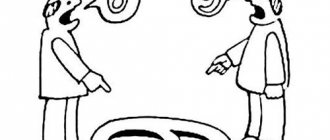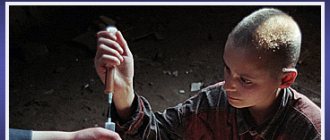Functions of the family as a social institution
The main functions of the family include:
- reproductive, that is, procreation;
- education and training, socialization;
- maintenance and provision of family members (household and economics);
- spiritual and emotional development of family members;
- organization of joint recreation and family activities.
In the modern world, there is a distortion of the work of the family, its dysfunction and degradation as an institution. The current state of the family is characterized as a crisis. The main problems and difficulties include:
- decreased birth rate;
- an increase in the number of divorces;
- devaluation of family values, including in relation to raising children;
- an increase in the number of low-income and single-parent families;
- deterioration in the health of children and spouses;
- changing family roles;
- increase in domestic violence.
Structural and functional changes in the institution of the family have led to a breakdown in the traditional parent-child relationship. There is a decrease in the role of family education. More often, the functions of the family are assigned to other social institutions. Which, in my opinion, is not true and leads to qualitative and quantitative negative changes in society.
Family functioning is in turn influenced by:
- cultural norms and values;
- economic sphere of society;
- demographic changes;
- government institutions;
- physiological processes;
- psychological dynamics of intrafamily relationships.
It is worth noting that no other social institution can fully replace the family. As well as correcting the mistakes, consequences and pedagogical neglect of those generations who grow up during the crisis of the social institution of the family.
Therefore, it is important to talk about what a family should be like for the successful socialization of the child and its other members. And, of course, change the situation.
Family: nuclear and extended, patriarchal and partnership, family functions.
A family is a small group based on marriage or consanguinity, the members of which are connected by a common life, mutual responsibility and mutual assistance. This is a classic definition of family, wandering from textbook to textbook - it is better to memorize it, although familiarization with other definitions and materials (if you have free time) will not hurt at all.
Extended and Nuclear Family: The extended family is traditionally defined as a social unit that includes parents and children, as well as other, more distant relatives—perhaps grandparents or aunts and uncles—living together under the same roof. The term is now used more broadly to describe a set of looser kin relationships in which the nuclear family maintains contact through various means with the wider kin but does not form a single household with them. The typical family form in modern industrial societies is therefore not the isolated nuclear family, but the modified extended family. Ties between members of modified extended families are maintained in different ways in modern Britain. For example, recent research (Social Trends, 1997) found that most people live within an hour of their parents, siblings, and other relatives and say they see them at least once a month. In case of more remote residence, contacts are maintained by telephone or in some other way. One British study (Finch and Mason, 1993) shows that members of extended families share a network of responsibilities and exchanges of services, from lending or donating money to looking after children in the absence of parents. Finally, as evidenced by the Attitude Survey Data (Social Trends, 1997), people continue to hold positive views about the role played by members of this wider family circle in their lives. For example, in a survey, only 7% of people said that friends are more important to them than family.*
Nuclear families, as social units consisting of a man and a woman who live together with their children, are often contrasted with extended families. One theoretical approach suggests that there is a "functional fit" between the nuclear family and the process of industrialization, since the nuclear family, free of extended kinship ties, is more geographically and socially mobile, provides greater emotional support through unlimited choice of marriage partner, and makes it possible to fill occupational roles. based on achievement criteria that meets the requirements of an industrial society. Thus, it is argued that family structure in modern society consists of relatively isolated nuclear family households, although this does not exclude the existence of significant social variations. Recent studies indicate the following. (1) Not all family structures in the period before the Industrial Revolution had the classic extended family form. In fact, due to the high mortality rate, the predominant form was the nuclear family. (2) The process of industrialization was accompanied by increased use of extended kinship contacts, partly through exchanges of favors and financial assistance. Such mutual aid systems supported people who found themselves in precarious situations due to migration from rural to urban areas. (3) There is now significant evidence that the family structures of industrial societies are not characterized by isolated married households. Modern families are more accurately viewed as modified extended families in which extensive contacts are maintained between relatives who do not necessarily live together in the form of visits, telephone calls and exchanges of favors. In this system of mutual support, those who are not related can also play an important role, forming a modified primary group around each family. The idea of the family as a unitary phenomenon is to a certain extent a misconception. Apart from the usual nuclear family consisting of wife, husband and children, there are a number of household structures. In Britain there is a trend towards smaller household sizes, more people living together before or instead of marriage, more divorces, more remarriages and more children born out of wedlock. Such changes in household structure to some extent challenge the functionalist theories of the family that were common forty or fifty years ago. The authors of these theories believed that the family is a universal human institution because it performs certain functions that are crucial for society, such as socialization, caring for children and reproduction of the population. However, the situation in modern societies is different not only in that the number of families of this type is decreasing. It is also likely that this family structure creates certain difficulties for society and for family members. Families can be either functional or dysfunctional (see: Dysfunction). For example, some modern writers have argued that women are oppressed within the family, with permanent psychological damage to those involved.*
Patriarchal and partner (democratic) family: The patriarchal family is a form of family in which power rests undividedly with the eldest man. Often it has an extended composition, that is, it includes several generations of relatives.** In history and culture, there are indeed many examples of extended patriarchal families, for which the leadership of the eldest man is a way of organizing a large family group. However, we should not lose sight of the nuclear patriarchal family, which exists in conditions favorable for the survival of a small group of relatives, but still presupposes the economic use of mainly brute physical force, which leads to strict economic specialization of men and women, an increased role of violence and, accordingly, the hierarchization of relations between relatives (the primacy of a man lies in the fact that economic resources are concentrated in his hands, and because of this he makes the main decisions). In a patriarchal family, absolute parental power and an authoritarian system of education dominate. See also Patriarchy. So, the key features of a patriarchal family: – economic dependence of a woman on a man; – clear division and consolidation of male and female responsibilities (functions); - male leadership in the family.
A partner family assumes equal status of spouses and a more lenient attitude towards children. It allows joint discussion of family problems, mutual trust, acceptance and autonomy of family members. The democratic family has emerged in the countries of European culture in the last 150-200 years mainly in connection with urbanization, the development of capitalism and the spread of mental work, which together allowed women to acquire their own economic role, leave the guardianship of husbands and fathers and achieve equal civil and political right In this situation, the perception of a woman as a dependent family member has become an anachronism, although the inertia of consciousness before the 1960s. (in Europe and the USA; until the 1930s in Soviet Russia) helped to dominate the image of a woman as a person leading a predominantly domestic lifestyle, as opposed to the social activity of men, which entails unequal access to making important decisions in the family. See also How ideas about family are changing in Russia. Key features of a partner family: – fair division of household responsibilities; – joint discussion of problems and decision-making by all family members; – emotional intensity of family relationships.
Family functions: Reproductive function - giving birth to children.
Educational function - i.e. subsequent education of born children. It can also be designated as a teaching function. The functions of primary social control, socialization / family as an agent of socialization are closely related to the educational function. Their specificity, however, is that primary social control and socialization as an endless process of integration and reintegration into society are also addressed to adult family members.
Socialization function. Despite the large number of institutions involved in the socialization of the individual, the family occupies a central place in this process. This is explained primarily by the fact that it is in the family that the primary socialization of the individual takes place and the foundations for his formation as a personality are laid. The family is the primary group for a child; it is from here that personal development begins.
Function of primary social control. Ensuring compliance with social norms by family members, especially those who, due to various circumstances (age, illness, etc.) do not have sufficient ability to independently structure their behavior in full accordance with social norms. A family is a small social group in which they learn to structure their behavior in accordance with existing social norms. Moral regulation of the behavior of family members in various spheres of life, as well as regulation of responsibilities and obligations in relations between spouses, parents and children, representatives of the older and middle generations.
Economic (economic) function. Satisfying family members' material needs (feeding the family, acquiring and maintaining household property, clothing, shoes, home improvement, forming and spending a household budget). Maintaining a common household by family members. Social production of the means of life, restoration of the forces of its adult members spent on production. Organization of consumer activities. To describe a family through the prism of an economic function, there is an economic term 'household'. In early capitalist agrarian economies, the family was seen as the basic unit of both consumption and production. Family firms were the backbone of the economy. In modern society this is often not the case, but the family in many industries can still be a production unit.
Social status function is the transfer or attempt to transfer by inheritance the basic characteristics of social status: education, income, access to power, place in culture, ethnicity, place in the social stratum, etc. As a rule, parents with higher education seek from their children and for After receiving a similar educational status, representatives of the middle and upper classes try, even at the start of their careers, to provide their children with a position that would allow them not to fall in income below their parents, etc.
Communication function. Organization of intra-family communication, leisure and recreation related to communication. Mutual cultural and spiritual enrichment.
The emotional-psychological (psychotherapeutic) function of a family is the satisfaction of its members’ needs for sympathy, respect, recognition, emotional support, and psychological protection. This function ensures emotional stabilization of members of society and actively contributes to the preservation of their mental health.
Recreational (recreational) function. Joint organization of entertainment and recovery after work. Caring for the health and well-being of family members. Rest, organization of leisure time.
Sexual-erotic function - there is such a thing.
*Abercrombie N., Hill S, Turner B.C. Sociological Dictionary, 2008 **Encyclopedic Dictionary. 2009.
- Tweet about it
- Share on vkontakte
- Subscribe to the comments on this post
- Print for later
- Bookmark in Browser
- Tell a friend
Family types
There are 3 types of families that have different influences on the social development and formation of the child’s personality.
- Families are close-knit, harmonious, with a high degree of moral orientation. These are socially prosperous families who can and want to raise a child. In case of any difficulties, it is easy to help them.
- Families are coordinated, but periodically unstable, with an average degree of social and moral orientation. These families are preoccupied with their own internal conflicts, so they would like to raise their children, but they cannot always (it does not always work out). Relationships within the family are tense. Parents make many mistakes, the goals of education are seen vaguely, the methods and means of education are not fully understood and are not used to their full extent.
- Families are disorganized, conflict-ridden, with a low degree of social and moral orientation. These are “problem” families. Are asocial or antisocial. There are several subtypes of such families: outwardly calm families, volcano family, sanatorium family, illusion family, “third wheel” family, family with an idol, masquerade family.
Prosperous and dysfunctional families
A person’s entire future life is shaped according to how his parents treated him and each other. Parents are constantly open and must monitor themselves every second and be aware of their parental pedagogical responsibilities. Whether they want it or not, the child systematically correlates his parents’ teachings with their way of life.
Based on the type of relationship, we can distinguish prosperous and dysfunctional families. I propose to get acquainted with this material in the form of a table.
| Group of families | Subgroup | Characteristics of parental attitude |
| Prosperous families | Understanding | Parents accept the child, do not try to change, always try to understand his point of view and build a dialogue. Parents really evaluate themselves and their child. They can protect the child and meet all his needs. |
| Patronizing | Parents adequately evaluate themselves and the child, clearly understand his needs and abilities, but retain the position of leader and power. They do not enter into dialogue and believe that they always have the last word. | |
| Indifferent | Parents only care about the external picture of the family and child. They know little of his inner world and do not want to know more. Children from such families are always outwardly prosperous, but in reality the parents are more busy with their own problems than with their children’s. | |
| Dysfunctional families | Overwhelming | The main methods are prohibitions and orders. The child is rejected. Child-parent relationships are unstable. Although parents believe that they know their child, they cannot predict his behavior. |
| Alarming | Parents are anxious and unsure of themselves and do not know their children. Because of their own insecurity, they are often cruel. Relationships are contradictory. | |
| Detached | Parents are critical in their judgments and adamant, often harsh, and never enter into dialogue. They place increased demands and expectations on the child. At the same time, they are strongly attached to the child. | |
| Rejectors | There is no focus on the child, it’s as if he doesn’t exist. Parents emotionally reject the child and are not interested in his problems or inner world. They don’t know their child well, but, oddly enough, they adequately assume his behavior. |
According to educational potential
Based on the level of educational potential, the following types of families can be distinguished.
Educationally strong family
The educational capabilities of such a family are close to optimal. Attention is paid to the microclimate in the family, the nature of the relationships between its members and the style of family education that has a beneficial effect on the child.
Educationally sustainable
Overall favorable educational opportunities. Emerging difficulties are overcome with the help of other social institutions, such as schools.
Educationally unstable
The incorrect pedagogical position of parents is characteristic. For example, overprotection, authoritarianism, connivance, etc. But at the same time, this position is easily closed and corrected. That is, the educational potential of the family is great, but the results of education require correction in relation to parents and children.
Educationally weak, with loss of contact with children and control over them
Families in which parents, for certain reasons, are not able to raise their children properly. For example, poor health, excessive workload, lack of education and pedagogical culture. Conflicts as such are not noticed, but there is a constant loss of family influence on children. Often the child goes into an informal subculture.
Within this group, several more types can be distinguished:
- educationally weak with a constantly conflicting atmosphere or aggressively negative;
- marginal, that is, families with any social deformations and deviations;
- delinquent;
- criminal;
- psychologically burdened family.
By number of children
Types of families and their characteristics are varied. The fact is that in psychology, as in any other field, division can be made from different positions. For example, by the number of children.
There are childless families. Or, as they are now commonly called, “childfree”. Usually these are couples who do not have any children: neither adopted nor their own. You could say, just a man and a woman getting married.
A one-child family is one in which there is only one child. Quite a common option in Russia. In a psychological sense, such a decision may entail certain consequences. For example, there is a high probability of raising an egoist.
A small family is a family in which, as a rule, there are two children. It also occurs very often. Psychology plays an important role in such a unit of society. We will have to maintain harmony in relationships so as not to damage the fragile child’s psyche with the birth of a second baby.
Large group - a unit of society that has 3 children. Although it is now customary to call such families medium-sized families. This concept has almost become obsolete, since few people in Russia now have more than 3 children. If we rely on the concept of average children, then these are “communities” in which there are 4 or more children.
Parental authority
The effectiveness of the family as a pedagogical system and social institution depends on the level of parental authority. Speaking about the authority of parents, I would like to turn to the theory and classification of the great teacher A. S. Makarenko.
The author highlighted true authority, which implies:
- a decent life for parents;
- decent work for parents;
- their behavior;
- their knowledge of the child's life;
- helping a child;
- a sense of responsibility for raising a child;
- civilian parents.
At the same time, Makarenko identified several false authorities that have a detrimental effect on the child and family relationships.
- Suppression. The child begins to lie, becomes cowardly and cruel.
- Distance. The family is ultimately of no value to the child.
- Swagger. The child grows into an arrogant and authoritarian person.
- Pedantry. The child becomes passive and submissive.
- Reasoning. The child becomes alienated from the family and, possibly, the entire society.
- Bribe. Raises an immoral conformist.
- "Love". Unreal parental love cultivates deceit and selfishness in the child.
- "Kindness". The same “kindness” brings up an authoritarian and selfish person.
- "Friendship". Trying to become best friends leads to the formation of a cynical and unprincipled child.
Pedagogical culture of parents
The pedagogical culture of parents is a separate, powerful factor influencing the style and type of upbringing, and, accordingly, the development of the child. An abnormal atmosphere in the family often contributes to the formation of anger, aggressiveness, deceit, or, on the contrary, isolation, passivity, and timidity. Such manifestations in the child’s behavior indicate a weakening of protective psychological mechanisms.
- An unfavorable family environment and the child’s internal personal negative traits together create loose soil under the child’s feet; he becomes vulnerable to external influence and antisocial behavior.
- Children from disadvantaged families with a low level of pedagogical environment grow up cynical about the world; they are proud of their immoral actions and ignorance of generally accepted values.
I would like to introduce you, dear readers, to the levels of pedagogical culture of parents.
High level
Awareness of the goals and objectives of education
Parents are aware of the goal of education (the formation of a harmoniously developed, socially active personality), understand what areas education consists of, and imagine what personality traits need to be formed at each age stage of the child’s development.
Ability to cooperate with children
The requirements are reasonable, love and severity are in adequate proportions. Relationships are built on mutual respect and trust. Problems are solved together through situation analysis.
Mastery of parenting methods
Parents focus on the child’s positive qualities, provide him with initiative, support independence, encourage introspection and self-education, and teach him to overcome difficulties. Parents and other family members adhere to a single educational position.
Average level
Awareness of the goals and objectives of education
They understand the directions of education, but do not connect them with the main goal. They imagine what traits need to be formed, but do not always correctly associate them with the child’s age.
Ability to cooperate with children
The requirements are reasonable, but not systematic. Parents often take the initiative in solving problems. There is mutual respect in the family, but the parents do not want to move towards cooperation and try to maintain a dominant role.
Mastery of parenting methods
Parents focus on the child’s positive qualities, but do not provide him with initiative, do not prepare him to solve problems, independently overcome difficulties and self-improvement. Sometimes in a family there is a discrepancy in the educational position of parents, grandparents.
Low level
Awareness of the goals and objectives of education
Parents do not know the goals and objectives of education, do not understand the direction, and do not know what traits need to be formed. Sometimes they can imagine these traits abstractly, but not in relation to their child.
Ability to cooperate with children
Children and parents do not understand each other, do not respect each other, do not trust each other. Requirements from parents are of an everyday nature. Parents are not interested in the child's problems.
Mastery of parenting methods
Authoritarian methods predominate: order, instruction, demand, punishment. Parents either suppress the child’s initiative or, on the contrary, provide uncontrolled freedom. They don’t pay attention to the child’s positive traits. There is no single educational concept in the family; the behavior of family members varies from permissiveness to excessive punishment.
Obviously, the higher the level of parental pedagogical culture, the more favorable the relationship is for the family and the child.
By the way, the family may not know the pedagogical subtleties, but by their own successful example they can raise a harmonious personality.









